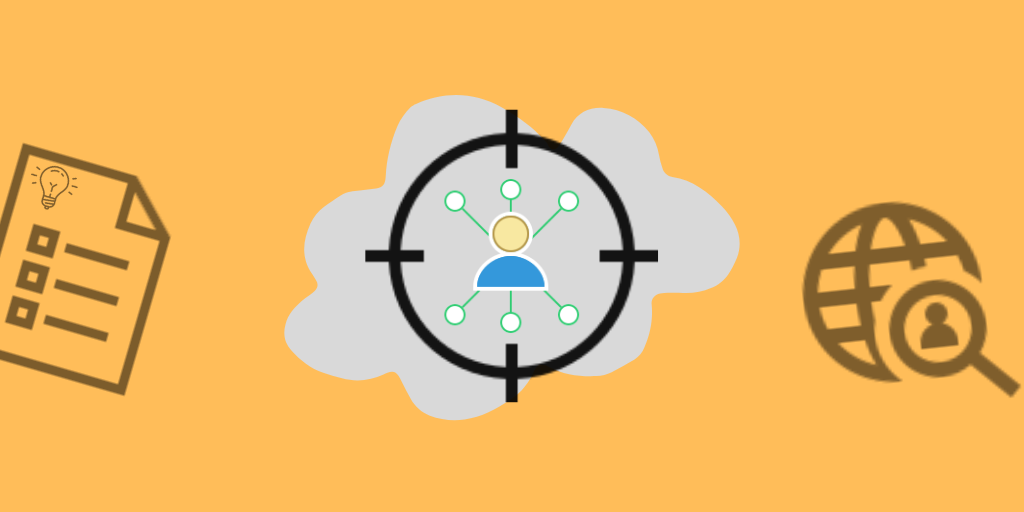“The aim of marketing is to know and understand the customer so well, the product or service sells itself.” – Peter Drucker
How can your company understand hundreds or even thousands of different customers? This is where buyer personas come into play. Buyer personas give your customers a face and enable your content marketing and sales teams to engage in a customized marketing campaign.
How do you write a buyer persona? What is a buyer persona template? And how do you create a unique persona that perfectly reflects your target audience? These and many more frequently asked questions will be answered in the following in-depth buyer persona guide.
Supercharge your content reviews
Share, review, and approve all your content in one place with Filestage.
What is a buyer persona?
A buyer persona is a fictional character that represents a segment of your customers. It can also be known as a marketing persona, customer persona, or user persona. A buyer person may also stand for a market segment you are aiming to reach. Simply put, a buyer persona is a generalized archetype that represents a larger target group.
In other words, creating a buyer persona helps illustrate the needs, goals, skills, attitudes, and behavior patterns of your customers. You will know exactly who your customers are and how to best approach them.
A buyer persona contributes to the bottom line of your business. With buyer personas, you can systematically engage with your highest value customers to deliver exactly what they need. This fact alone will help your sales grow.
Additionally, buyer personas help marketing teams publish the most relevant content for the right audience, as they know exactly what their audiences desire, value and appreciate. Therefore, utilizing a marketing buyer persona increases your overall marketing ROI and enables your team to get started on projects faster.
Buyer personas can be used across all industries and throughout the product lines of your company. Usually, a business sets up multiple buyer personas according to each persona’s purchasing power, interests, values, or other qualities.
At Filestage, we provide an online proofing solution for creative professionals and enterprises of all sizes. So, we needed to create many different buyer personas, including art directors, designers, and filmmakers. These personas have helped us understand different customers as well as the needs and desires of each specific target audience.
Download a free buyer persona template
Fill out the form below to get instant access to our buyer persona template.
To save an editable copy, follow these simple steps:
- Click “File” in the top-left corner
- Click “Make a copy”
- Choose your destination folder
What’s the difference between a buyer persona and an ideal customer profile (ICP)?
Before delving into the details of how to create a marketing buyer persona, we need to explain the difference between a buyer persona and an ideal customer profile (ICP).
While a buyer persona focuses on an individual person, an ideal customer profile describes an entire company. An ideal customer profile includes qualities such as industry, size, revenue, budget, and other economic factors, which you would usually not find inside the profile of a buyer persona.
What is an ideal customer profile (ICP)?
Therefore, an ideal customer profile is mainly used in a business-to-business (B2B) and account-based marketing context. If your company works in a B2B environment, an ideal customer profile gives you a good overview of the capabilities and profitability of your company accounts, while buyer personas help you specifically serve individual stakeholders.
Whether you work for a business-to-customer (B2C) or B2B company, there are plenty of benefits that can come from developing useful buyer personas and getting to know the needs, wants, and desires of individual customers. Using buyer personas, you can make informed decisions and specifically serve your audience.
Moreover, you can enhance your communication plan and achieve better marketing and sales outcomes through the use of buyer personas. They allow you to shift from one-size-fits-all marketing messages to tailored solutions for your target audience, which are much more likely to be effective.
Furthermore, your personas will increase the ROI of your content marketing strategy, as they offer a blueprint of how to approach your targets. This minimizes unnecessary advertising spending and increases your ROI.
How do you write a buyer persona?
Before you can create compelling buyer personas, you need to make sure that you take a structured approach. Otherwise, you may end up with fictional characters that do not reflect your actual customer base.
Therefore, you need to conduct thorough research into your target market’s demographics and then distill your market research data in order to find the most common denominators of your customer base.
Based on your findings, you can then start creating your buyer persona – one that contains all of the important characteristics that precisely reflect your audience.
The following sections describe each step in detail.

1. Conduct buyer persona research
Extensive customer research is the foundation of your buyer persona. Depending on the scale of your business and the resources available, you might skip one or two steps. However, the more research you undertake, the more precise your buyer persona will be. In the following, we outline suggested research steps in detail.
Talk to your customers
Talking to customers is by far the best way to gain meaningful insights. Prepare an interview script with frequently asked questions about values, decision-making, goals, and problems of your audience. Execute these interviews either in person or over the phone. Talk to good as well as bad customers. As painful as this can be, unhappy customers are a great source of new insights.
Is your product not quite ready, or are you just new to the market? No problem at all. Just interview potential customers instead. Sometimes people have trouble reflecting on their own behaviors. Use the “5-why-technique” to get to the core of their motivation.
The 5-why-technique is a question-asking strategy that allows you to explore the root cause of a problem. By repeating the question “Why?” five times, you can dig deeper to uncover underlying issues. Each answer you receive forms the basis of the next “Why?” question. Sakichi Toyoda, the founder of Toyota Industries, developed this technique. Of course, you won’t ask “why” five times in a row to your client. But you get the point. This technique is a thought-provoking impulse for client communication.
Set up a survey
Create an online customer survey, and distribute it to customers within the target group. Keep the whole survey short and simple, with no more than ten questions. An old rule of thumb in market research says: The longer your survey, the fewer people will take part.
You can mix qualitative and quantitative questions in your survey. This means you can include some multiple-choice questions as well as open questions. You can ask a closed question to get the customer’s age, for example. Or, you can ask open questions like: “What pain points do you currently face?”
Quantitative questions are easier to analyze but often provide fewer insights. Open questions in contrast, have a higher likelihood of provoking dropouts.
Check your (site) analytics
Good data sources can be found within site analytics. Analytics give you a great overview of typical visitors. You can easily reveal the desires that lead the audience to a site. Where did your visitors come from geographically, what devices did they use, what sites and keywords did they search?
Furthermore, you can check tracking data on advertising. This is a great way to see what messages your target group responds to the best. Plus, you can also use internal data, such as sales data, to learn more about your customers.
Research on social media platforms
Social media is a great avenue for finding out more about your customers. The easiest way to get more information about your buyer personas is to use monitoring tools provided by the platforms. These tools show you how your followers are behaving and what content they’re engaging with the most. You can also extend your analytics through social media listening tools such as Hootsuite Insights.
Interview customer support and sales people
A good starting point for gathering customer data are your team members who interact with customers on a daily basis. They often have a deep understanding of their clients. You can set up personal interviews, group discussions, or even send an internal survey to ask them about the customers.
It’s an easy way to gather data for your buyer persona. But be warned: Employees can get stuck in a routine. In some cases, they may not be able to easily identify the real interests and concerns of your target group.
Distill your research data
Before you use your research data to build buyer personas, you need to take an important step: Distill your data to its core. The best way to do this is by identifying patterns. Filter out the commonalities in your data. The more times an issue repeats in your data, the more important this item is.
Common buyer persona questions
A buyer persona helps you understand your audience. In order to create a good buyer persona, you should cover all of the relevant questions. While some questions may be superficial, others can go into much more detail.
The more questions a buyer persona can answer, the easier it is to create focused marketing and sales campaigns. As every small aspect of someone’s life can affect how likely they are to buy your product, you should list as many questions as possible.
In the following section, we summarize some of the most important questions that a good buyer persona should be able to answer.
Demographic information
- How old is your buyer persona?
- What is their gender?
- Where does the user persona live?
- What is the religious background of the user persona?
- What type of home did they grow up in and where do they live now?
- What nationality are they?
- Do they rent or own their home?
- Who does the user persona live with in the home?
- What is their relationship status?
- Do they have children? How many? What ages?
Financial background
- What is the job title of the buyer persona?
- What is their current salary (or company budget)?
- Do they work for a big company? How many people work there?
- Are they in debt? How much?
- Do they overspend regularly?
- Are they often incurring more debt?
- What are their biggest monthly expenses?
- How much disposable income do they have per month?
- How much are they willing to spend on products like yours?
- What would they consider value for money in terms of your product?
Customer needs
- What motivates them?
- What three words would they use to describe themselves?
- What are their key needs?
- How can these needs be met?
- Can your product or service help them meet their needs?
- What areas regarding the product could be improved to better serve this customer?
- What are the main concerns and worries of the user persona?
- What are they looking for in products and services like yours?
- Why would the user persona need to buy your product?
- What is their opinion of your product and company?
2. Create a buyer persona
How do you create a new persona? The strongest buyer personas are based on insights you gather from your existing customer base. After you have distilled all of your research data, you should be able to create your buyer persona and add all information needed.
When creating your user persona, structuring and presenting information in an informative and engaging way is a science of its own. Therefore, this section explains in detail what information your buyer persona should contain. Then, the following sections give you advice on how to structure your buyer persona presentations in the most meaningful way.
Buyer persona template
Use this template to create effective buyer personas that help you to stay focused.
Name and photo
What is a typical name for someone in your target group? What does the person look like?
Every buyer persona needs a name and a face. People within your organization will relate much easier with the character this way. It makes your persona more authentic and much easier to visualize their needs and desires.
Example:
Let’s pretend one of your main markets consists of young male creative producers. A common name could be David Lubars.
A good way to come up with a name: Talk to your sales team. What’s the first name that pops up in their mind? You can also check your customer lists for names. Useful websites to find names and photos for your personas are UI Names, UI Faces and Random Users Generator.
Quote
What quote summarizes the character of your buyer persona?
Try to formulate one statement that represents the values, goals and challenges of your buyer persona. Make it look like a real quote. This will provide a helpful summary or tag line for your buyer persona.
Example (statement)
“I don’t mind working long hours, because I love to create innovative campaigns for my clients. But sometimes, I wish the communication process with my clients would be easier.”
Background information
Who is your character?
Besides a name, you need to add some background information about your buyer persona. This will make your character more vivid. Think about the typical age, gender, job, education, location, and family situation of your buyer persona. Try to find archetypal information that shapes your fictional character.
Example (Use bullet points):
- Age, gender: 31 years old, male
- Job: Creative Producer
- Education: Bachelor’s degree in advertising and PR
- Location: Los Angeles, California
- Family situation: Single
- Archetype: Straightforward Advertising Professional
Goals
What are the person’s goals when looking for a product or service?
Supercharge your content reviews
Share, review, and approve all your content in one place with Filestage.
Clearly state the goals your user persona has when using a product / service. What does your character try to accomplish when buying your product / service? Look for real insights on your target group here. These objectives represent the key drivers of your buyer persona. In most cases they are not as clear and obvious as they seem at first sight.
Example (3-5 bullet points):
- Striving for promotion
- Eager to win awards and/or recognition for his advertising campaigns
- Wants to build great relationships with all of his clients
- Wants to be in control
- Looking for more effective ways to work
Challenges, fears, and problems
What problems does your buyer persona face right now?
Try to figure out the problems your user persona has to solve. Clarify the major pain points, challenges and fears. When does your user persona struggle? Think about the work environment, the social environment, and even the health of this person. Concentrate on the issues and fears that relate to your product and service.
Example (3-5 bullet points):
- Feels pressured by his workload
- Can become stressed by the volume of client emails
- Struggles to handle the communication between his co-workers and his clients.
Values
What values and attitudes does your persona have?
This is all about the mindset of your buyer persona. Describe the mental model of your buyer persona. Does your user persona prefer a stable environment with fixed conditions? What are the beliefs, perceptions and attitudes of your character? Don’t expect the mental model to be obvious. It’s often unarticulated and hidden.
Example (3-5 bullet points):
- Seeking new ideas
- Freethinker
- Loves the art scene
- Practical minded and straightforward
- Loves the security of a stable income
Buying decision process
How do they make a buying decision?
One important fact you should include in your buying persona is the way buying decisions are made. What is the preferred buying channel of your character? Do they trust the referrals of friends or do they read journals to get product information?
List the channels your fictional character uses to gather information. Check the product lifecycle to get a deeper understanding. Figuring out if your buyer persona is an early adopter or a laggard makes it much easier.
Example (3-5 bullet points):
- Always busy, works long hours
- Prefers to gather information online
- Believes in the product referrals of bloggers
- Hates to be bothered by sales calls
Part of the buying decision process is to define what customer segment of technology adaption your buyer persona belongs in:
- Innovators
- Early Adopters
- Early Majority
- Late Majority
- Laggards
Our sample character David Lubars belongs in the group of the “Early Majority.”
Solutions (optional)
How can you help solve the problems outlined? How can you help your buyer persona reach his goals?
Once you’ve identified the core problems of your character, it’s time to offer solutions. What can your product or service do to overcome these obstacles? What does your fictional character need in order to reach his goals?
Be sure to address deeper problems, not only the obvious ones. Align your solutions with the values and the buying decision process of your character.
Including a practical solution to the problems of your buyer persona is optional, but can be useful and help give more focus.
Example (1-3 sentences):
- Approval software such as Filestage streamlines content review and approval processes with clients and colleagues. This solution helps David avoid long email threads and enables him to collect and manage all feedback in one centralized place.
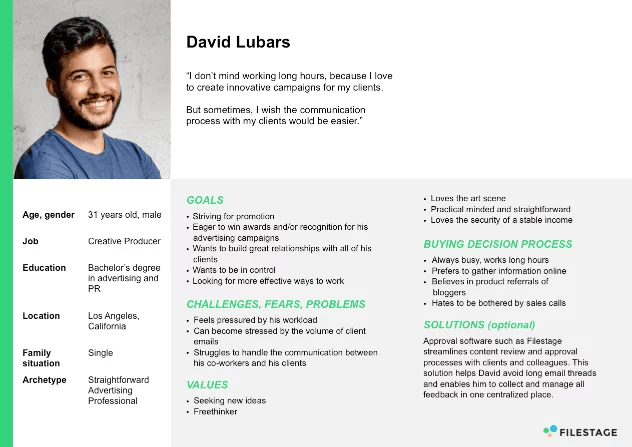
Practical Filestage buyer persona template – free download
Feel free to download our free buyer persona template (PowerPoint) right here. Not only is it free, it is a lean and straightforward buyer persona powerpoint template. Templates work as a common thread and prevent you from being too long-winded and unspecific. You can adapt our free practical PowerPoint/ PDF buyer persona templates to create effective buyer personas for your own organization’s needs.
Buyer persona software
Don’t have the time to sit and go through a customer persona template? You might ask yourself which tool you should use to create a buyer persona. Buyer persona software can be a great tool to enhance your current brand management software solution. Therefore, we have summarized the best software solutions that help your company identify the demographics of your audience and create useful buyer personas.
Make My Persona by HubSpot

Hubspot’s user-friendly tool is a great fit for very visual people. Rather than sitting and filling out a worksheet, you can create a visual character with an interactive tool. This is definitely a more fun option than using a typical buyer persona template, and the final product is a great visual buyer persona.
Xtensio

You can create a slick and professional buyer persona using Xtensio. It’s very easy to share content with your sales team and other departments to keep everyone on the same page! After all, it’s not just the marketing desk that needs to be familiar with your main market.
Everyone you work with should be aware of your strategy for your products and services. Xtensio has all the means necessary to spread awareness about your main markets within your organization.
Persona Bold
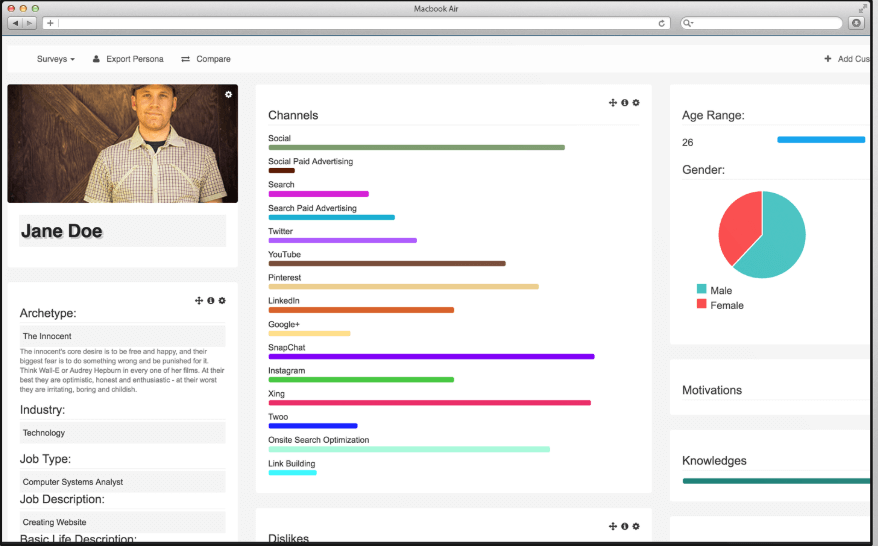
Persona Bold is not just a tool for creating buyer personas, it also offers multiple enterprise project management tools. The slogan “Work ON the business, rather than IN the business” manifests itself in a wide range of collaborative, strategic and organizational tools.
Its user-friendly interface makes it easy to create multiple buyer personas and share them with your team. The tool is customizable, which makes it perfect for any business purpose. Furthermore, Persona Bold offers every user a 15-day free trial to test the tool without any risks.
Alternative buyer persona templates and worksheets
A buyer persona template is really a flexible worksheet to facilitate the development of your content strategy. You need to find the best buyer persona template to help you target your customers with pinpoint precision. To save time, we have added multiple buyer persona template suggestions, which you can implement into your own buyer persona.
Customer avatar worksheet by Digital Marketer
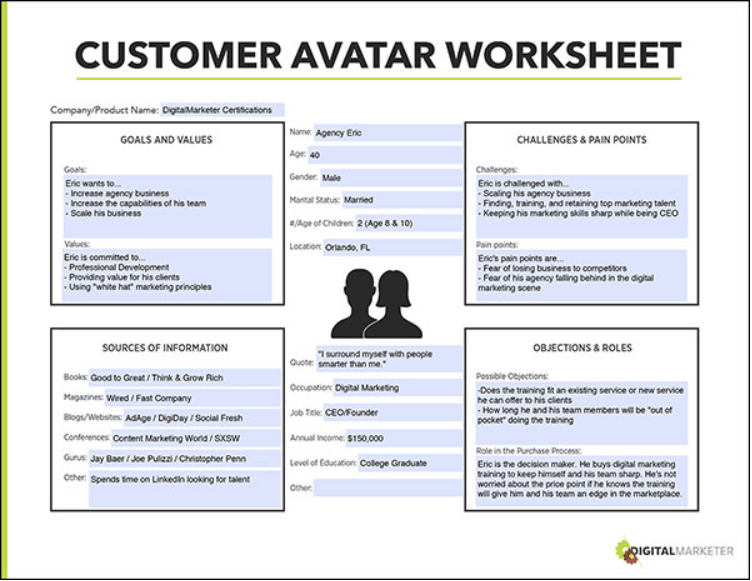
This worksheet by Digital Marketer demonstrates the design of their version of buyer personas: customer avatars. The avatar template includes goals and values, demographic Information, challenges and pain points as well as common objections and roles. You can include a persona’s specific goals and even more specific interests. This sheet helps you find your niche before you get to the interviews and research stage.
Buyer persona template by Demand Metric
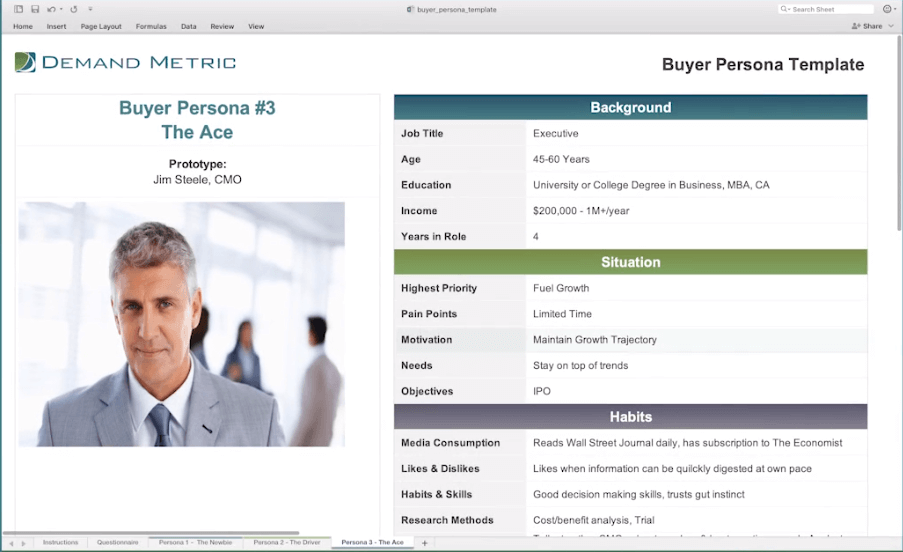
This professional template is easy to rebrand for your business and fit with your style. You can focus on the habits of target customers which may give you more insight into their wants and needs.
Additionally, this buyer persona template offers a great starting point to structure buyer information such as job role, education, demographics, revenue, priorities, needs, objectives, motivations and much more through an intuitive table.
Buyer persona template by HubSpot

Hubspot’s template is made with Powerpoint, so it’s incredibly easy to use. You can even include the early stages of your marketing pitch in this buyer persona template, which is a useful feature. The sections of this sheet are broken down into who, what, how and why – giving you a clear purpose when completing the worksheet.
Marketing persona cheat sheet by Marketo
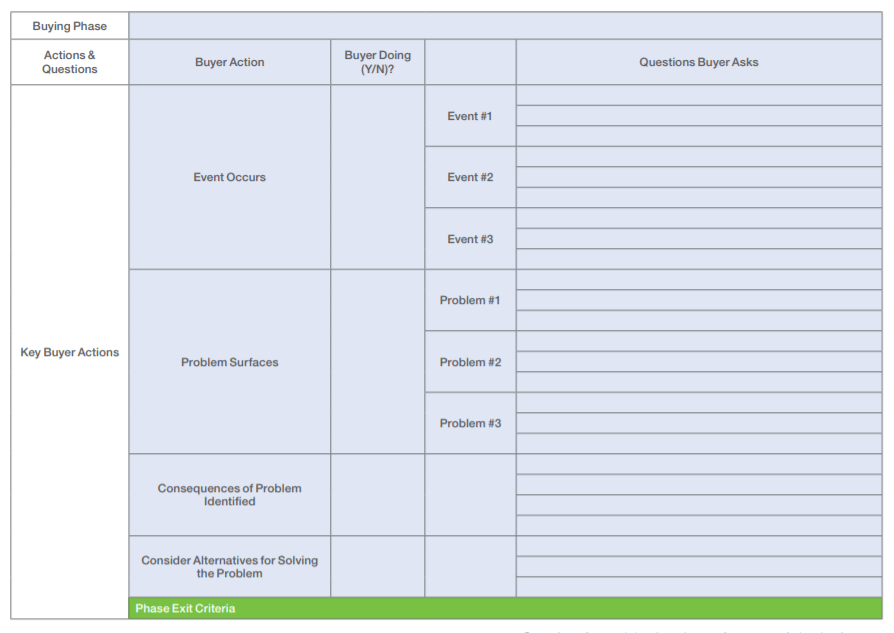
Marketo offers a slightly different take on buyer personas. Its buyer persona templates specifically emphasize your customer’s journey, which can further help you understand your target audience.
Marketo gives you the key areas you need for a customer persona, but then their template focuses on your buyer’s actions rather than personality. This is a good way to really get thinking about how to best use your buyer personas within your larger marketing strategy.
Free buyer persona template by Socialbakers
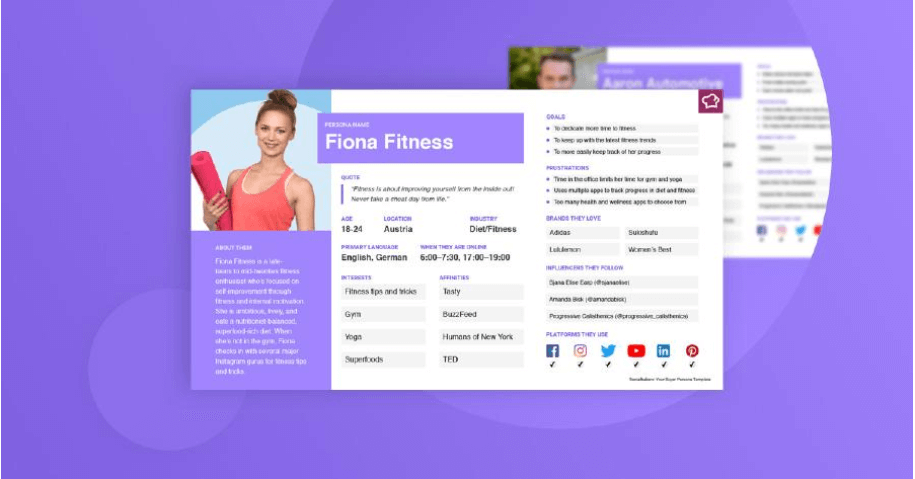
If you’re looking for attractive and smooth buyer personas, then this is the template for you. The aim of Socialbakers’ template is to consolidate all buyer information in a single place. This one person can give an overview of your entire potential customer base. Plus, the free download includes a wide range of newsfeed and buyer persona templates.
Buyer persona worksheet by Vendasta
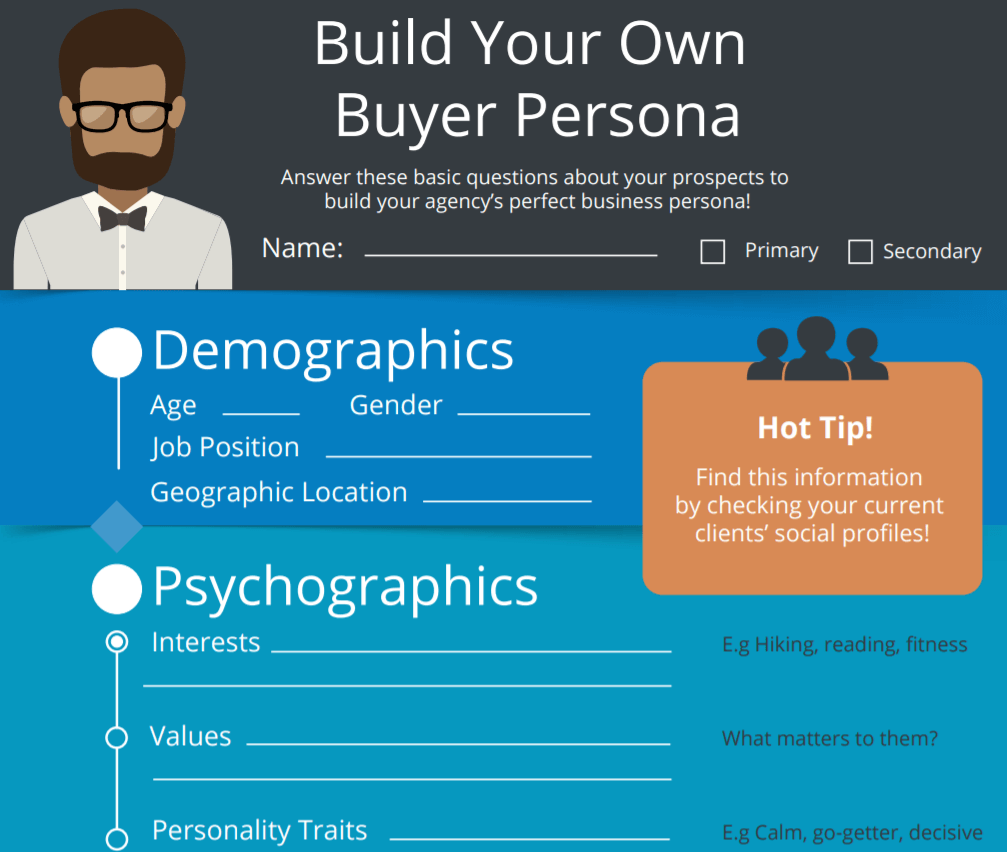
Vendasta’s colorful template helps you to very quickly hone in on the key information about your target group. This template is a good option if you’re particularly focused on social media marketing. Therefore, make sure to conduct thorough social media research before using Vendasta’s buyer persona template.
Buyer persona examples
In this section, we provide you with free, best practice examples that enable you to both define and present your target buyer. Each of these personas represent a potential target group for the products or services of your business. We prepared three buyer persona examples for B2B and B2C to add inspiration for your own personas.
B2B buyer personas examples
B2B personas differ from B2C customer persona examples. Usually, a B2B persona, such as a marketing project manager, puts a stronger emphasis on the organizational context, including company name, division, management function or financial information. The following section outlines three free B2B persona examples.
Buyer persona of Akoonu
Akoonu delivers a textbook example of B2B buyer personas. At a glance, you can see all important information related to the job and industry. Critics might argue that in times of increased hyper personalization, buyer personas should include more personal information and details such as life circumstances, demographics, interests, challenges and objectives to be the most approachable.
Buyer persona of Single Grain
With the profile of Single Grain, you can see all important background information, demographics, hobbies and many more details that give you a very precise impression of the character behind the buyer. In comparison to Akoonu, Single Grain offers much more detail at the expense of business-related information.
Buyer persona of Xtensio
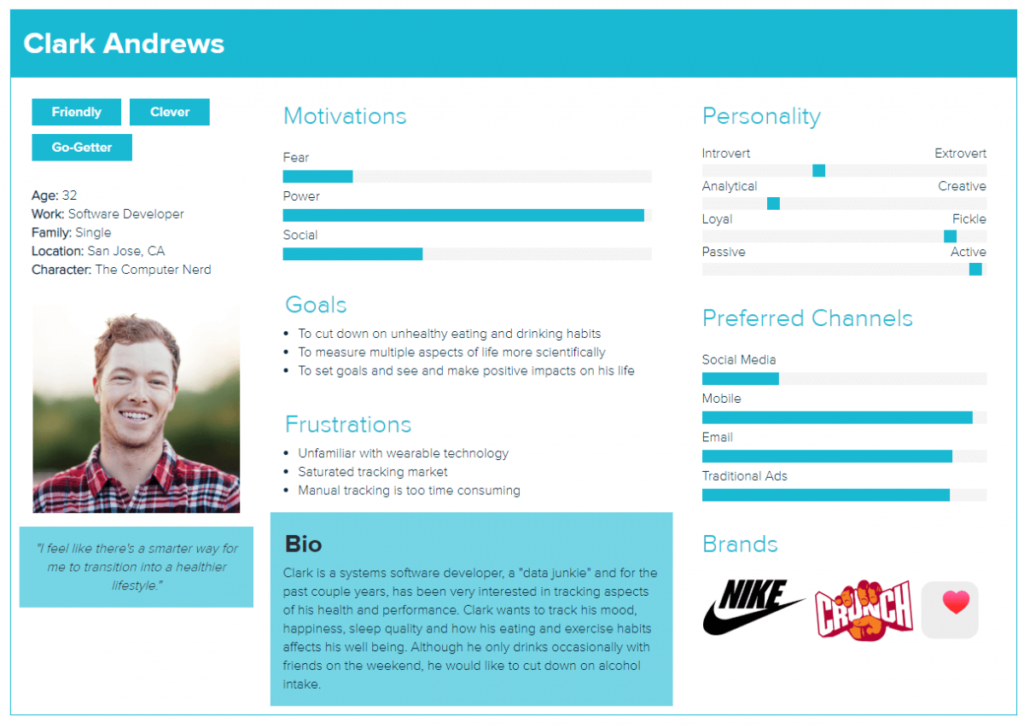
Xtensio offers a very clear example of why presentation is so important when it comes to buyer personas. If you plan to share the profile with internal or external stakeholders, visual representations and details such as bullet points, charts and brand logos make this presentation and process much easier. Therefore, collaborate with your design team when you create your final buyer persona summary.
B2C buyer personas examples
Compared to B2B examples, B2C buyer personas focus more on emotional needs, demographics, and the financial circumstances of individual buyers. Even if you are not familiar with a particular brand, you can gain clear insights into their philosophy just by studying their buyer personas. The following section lists three free B2C persona examples.
Buyer persona of Clearly Iron Springs Design

What information can be gathered through the buyer personas of Iron Springs Design? With one glance, you learn that their typical customers are young females with huge ambitions and a carefree mode of living. Instead of luxury, this customer base appreciates deals, coupons or other campaigns that protect the wallets of this lower-income target group.
Buyer persona of SmartBug
SmartBug created a B2C buyer persona that represents working mothers. When it comes to health care, mothers are often the most important target group inside a family. Working moms have two full-time jobs, so a quick and easy online service is a great solution for this particular target group. One glance is enough to see why a healthcare network adds a lot of value to a working mom like Wendy.
Buyer persona of Boscus Digital Marketing
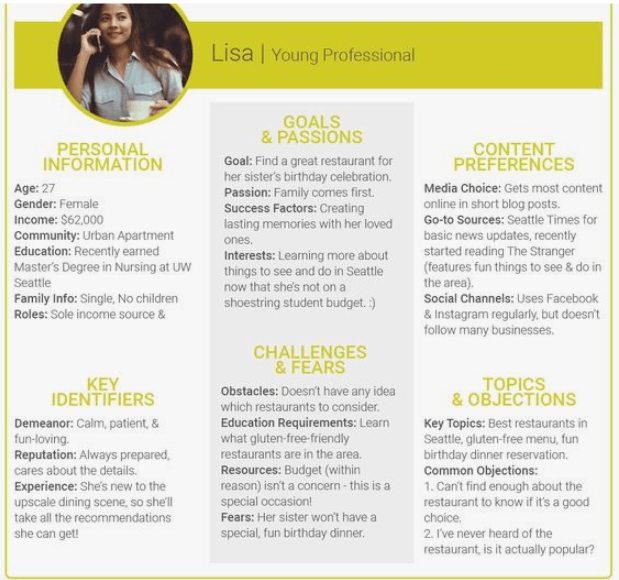
Boscus Digital Marketing delivers another valuable example for B2C marketers. Preferences are especially important when you create a marketing campaign around your buyer personas. Here we see that the main customer group, represented by Lisa, can best be approached through customized blog entries.
Conclusion
As you can see, creating buyer personas is a fantastic strategy for understanding your customers’ needs and motivations. Make sure to spend enough time on the research phase, as this stage is crucial to creating characters that accurately represent your customers. The more time you spend on the research phase, the more you sharpen your profiles.
A buyer persona is one of the most underestimated brand management and marketing tools, and it can directly contribute to the bottom line and the value of your business. Utilizing buyer personas also simplifies the work of your marketing and sales teams and may even help improve products and services.
Therefore, we encourage you to get started creating compelling buyer personas that boost the value of your business!

